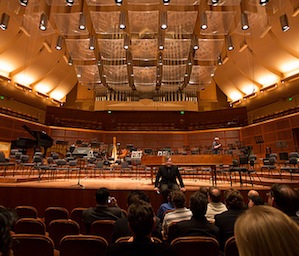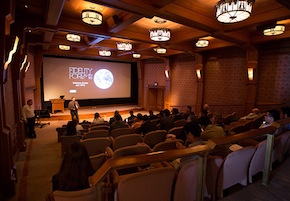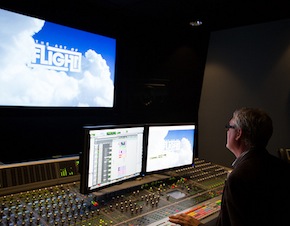
On May 17, when San Francisco–based Dolby Laboratories announced the availability of the first Blu-ray discs with sound quality noticeably improved by its new TrueHD process, one and only one classical music organization stood side-by-side with offerings from major movie production houses in both Hollywood and China: the San Francisco Symphony.
San Francisco Symphony at 100, an SFS Media HD Blu-ray disc offering both 5.1 and stereo mixes of the Symphony’s 2011 centennial opening night gala, is the first classical Blu-ray disc premastered with Dolby TrueHD advanced 96 kHz upsampling. The process, designed for use by studios, authoring houses, and mastering facilities, elevates playback performance of “lossless” audio on Blu-ray disc and is compatible with all Blu-ray players. (For a discussion of what 96 kHz means, see SFCV’s Sound Matters: Classical Into the Download Era.)
This is hardly the first time that the S.F. Symphony has been on the cutting edge of advanced audio and video quality. Its continuing series of SACDs, beginning with its much-praised Mahler project, offers high-resolution sound in both stereo and surround-sound mixes. These recordings, also available as high-resolution and full-CD-quality downloads via HDTracks.com, are just some of the SFS Media projects that demonstrate how dedicated the orchestra is to delivering state-of-the-art sound to music lovers.

San Francisco Symphony at 100 augments footage of its music director, Michael Tilson Thomas, conducting performances of Copland’s Billy the Kid Ballet Suite, Mendelssohn’s Violin Concerto in E Minor (with no less a fiddler than Itzhak Perlman), Britten’s Young Person’s Guide to the Orchestra, plus a multimedia version of John Adams’ thrilling Short Ride in a Fast Machine with documentary vignettes tracing the SFS history, narrated by Amy Tan and produced by Janette Gitler. Dolby TrueHD has also been employed to upgrade the sound in Greater China’s release of The Flowers of War, the Joe Satriani concert film Satchurated: Live in Montreal, and several other initial offerings.
Jack Vad, the recording producer and engineer of the SFS, and John Kieser, the organization’s general manager, are the two men most responsible for the adoption of TrueHD and the development of SFS Media’s various audio, video, and television projects.
“I was the person who, probably in the late ’90s, made the first contact with David Kawakami, the public head of Sony’s [Sony Music Entertainment’s] foray into SACD,” Vad explained by phone. “More recently, I’ve developed a relationship with John Loose of Dolby Labs in which we consult and work with each other on projects.
This is hardly the first time that the S.F. Symphony has been on the cutting edge of advanced audio and video quality.
“John invited me to come over to Dolby and take a listen to Dolby TrueHD. Once I heard it, I felt it was a revelation. It was so close to what the original master was like that it was rather unbelievable to me.”
At that point, Vad initiated internal discussions with Kieser and others in which he pushed hard for Dolby TrueHD. “It has now become our standard for Blu-ray audio,” he reports. “I’m so happy with it, as are all my professional peers.”
Hearing Is Believing

As Stereophile’s representative at Dolby’s recent two-day Fidelity Forum 2.0, where I rubbed shoulders with 19 other members of the international press, I had the opportunity to experience firsthand the difference that TrueHD makes. In a session presented by Dolby Labs’ James Spezialy, senior application engineer in the firm’s Indirect Film Services, small groups of journalists heard side-by-side clips that compared Blu-ray’s standard 48 kHz sound with discs prepared using 96 kHz Dolby TrueHD.
At the start of the comparison, Dolby distributed an “ear training” sheet that included tips on what to listen for. The list included “clarity and naturalness to sound, longer ‘ring out’ to reverb and ambience, consistent audible quality as high frequencies decay, better definition between instrumentation, and more natural-sounding dialogue with a less granular quality to voices.” This may sound like audiophile jargon, but once the differences are experienced in an actual demonstration, it becomes possible to understand why music lovers listen more deeply, and longer, to Blu-ray discs encoded using Dolby TrueHD.
It becomes possible to understand why music lovers listen more deeply, and longer, to Blu-ray discs encoded using Dolby TrueHD.
As impressive as were sonic differences in clips from Lost Bladesman, Batman Returns, Kung Fu Panda, Flowers of War, and Satriani’s rock concert Satchurated, the most telling comparison came via a 27-second, audio-only clip from the San Francisco Symphony. In the switch to Dolby TrueHD, the overall flatness of the 48 kHz symphonic presentation ceded to 96 kHz’s far more involving, three-dimensional sense of air and space. Instrumental timbres sounded truer and more complete, with a more-lifelike sense of natural reverberation and decay.
As someone who attended the Symphony’s centennial gala, and knows the sound in Davies Symphony Hall from any number of premiere (and not-so-premiere) seats, I felt that Dolby TrueHD took me one step closer to being there. And while I may not wish to get any closer to Kung Fu Panda or his opponents — I have all the violence I can handle on the streets of East Oakland where I live, thank you — I’ll gladly cuddle up to the sound of San Francisco Symphony’s strings anytime I can. From what I’ve heard of Dolby TrueHD, the process succeeds in doing exactly what its developers intended.

